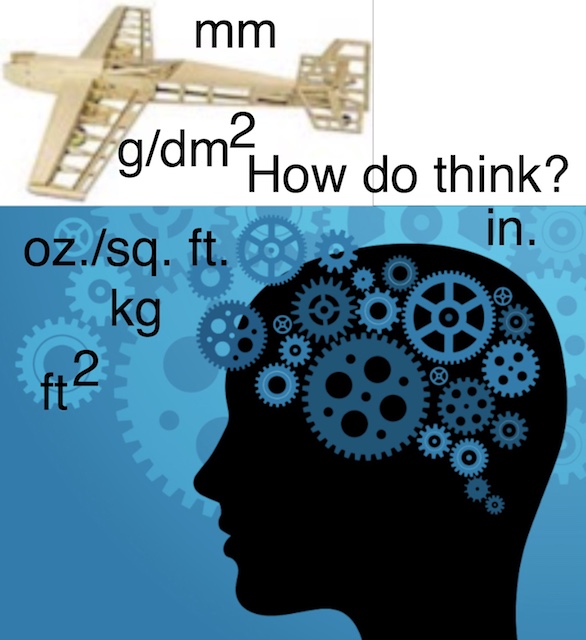 |
Flying High With Electric Power!
The Ampeer ON-LINE!
Fly the Future - Fly Electric! |
|---|
Site Table of Contents
| President: | Vice-President: | Secretary-Treasurer: |
| Ken Myers | Keith Shaw | Rick Sawicki |
| 1911 Bradshaw Ct. | 2756 Elmwood | 5089 Ledgewood Ct. W. |
| Commerce Twp., MI 48390 | Ann Arbor, MI 48104 | Commerce Twp., MI 48382 |
| (248) 669-8124 | (734) 973-6309 | (248) 685-7056 |
 | ||
| Board of Directors: | Board of Directors: | Ampeer Editor |
| David Stacer | Arthur Deane | Ken Myers |
| PO Box 75313 | 21690 Bedford Dr. | 1911 Bradshaw Ct. |
| Salem, MI 48175 | Northville, MI 48167 | Commerce Twp., MI 48390 |
| (313) 318-3288 | (248) 348-2058 | (248) 669-8124 |
| Upcoming EFO Meeting: January 12, 2022 Time: TBD
Place: Zoom | ||
| "Thinking" About Fixed Wing Aircraft Models and Your Brain Ken Myers discusses the various ways we "think" regarding our model planes and why. | Comment Regarding the "My LiPo Died" in the December 2021 Ampeer Burkhard Erdlenbruch shares his observation regarding the amp draw note in the article for Ken's Simple Cub. |
| Skymasters Indoor Flying 2021/2022 Skymasters' president, Pete Foss, fills us in on the indoor flying season in Pontiac, with some updated notes by Ken. | Indoor Flying at the Legacy Center in Brighton, MI Indoor Flying Announcement in Brighton, MI! |
By Ken Myers
As a group, fixed wing model aircraft modelers and fliers, we have been drawn to this hobby for many reasons. We've also entered fixed wing model aircraft modeling at various times in history, times in our lives, and physical places on our planet. Many of you reading this are in the USA, or possibly Canada, while several others are located in many countries around the world. Again, as a group, we also have a very large range of chronological ages. We also have a large range of experience and time involved with fixed wing model aircraft. It can be reasonably argued that fixed wing "model aircraft" pre-dated actual man carrying, full-size aircraft. At certain times, the lessons learned from those "model aircraft" provided the basic physics of flight for manned flight at its earliest stages. Unpowered, fixed wing, manned flight was explored as early as the beginning of the 1800s.
Note that George Cayley started with a "flying model" and then created a man carrying glider. Near the end of the 19th century (1800s), man carrying, fixed wing, powered aircraft started to evolve in many parts of the world including Wales, New Zealand and the USA. The aviation pioneering era is said to have been between 1903 through 1914 with powered flight becoming an established technology by the middle part of that time period. There certainly had to be young men, during that early period, attempting to create flying models as a hobby, not just as a profession to gain aeronautical knowledge. ""A. V. Roe flew a nine foot span rubber-powered model in a competition at Alexandra Palace in 1907, beating 129 other flyers with a flight of 30 yards, and using his winnings of £50 to build his first man-carrying triplane." Note the use of the words foot and yards as units of measure in the previous paragraph. The quote is from the BMFA, the British Model Flying Association, and uses units no longer used in Britain, or even in most parts of the world today. On that same BMFA page there are also other mentions of the measuring units that today are called "Imperial units of measure" or the Imperial system. In other places, on the same historical BMFA page, metric units of measure, now known as the International System of Units, abbreviated as SI, were used. "With Charles Lindbergh's successful flight across the Atlantic in 1927, companies also quickly recognized the nation's interest in aviation, and for the first time began to offer model airplane kits. Model aviation building and technology continued to develop through the 1930s and early 1940s, with such advances as miniature gas engines and balsa wood." "Two of the early model airplane kit manufacturers, the Ideal Aeroplane & Supply Company and the Cleveland Model & Supply Company."
As with full scale aviation, both Imperial units of measurement and SI units of measurement (metric units of measurements) have been used in modeling at different times and in different areas of the world. "Using different units to designate the same concept has lead to a lot of confusion when model aircraft hobbyists are trying to communicate with each other across the globe. "The measurement units the modeler's brain "thinks in" are fixed, depending on the time and place that a modeler enters the hobby. Attempting to "think in" someone else's different measuring units is exceptionally difficult, once the learned system has been ingrained into the user's brain through repeated and continuous exposures. Even working in the same system of measurements can present some problems. Full-scale planes are have historically used Imperial units; pounds, feet, inches, square feet, miles per hour and for model aircraft ounces, pounds, inches, ounces per square foot and miles per hour in many parts of the world. 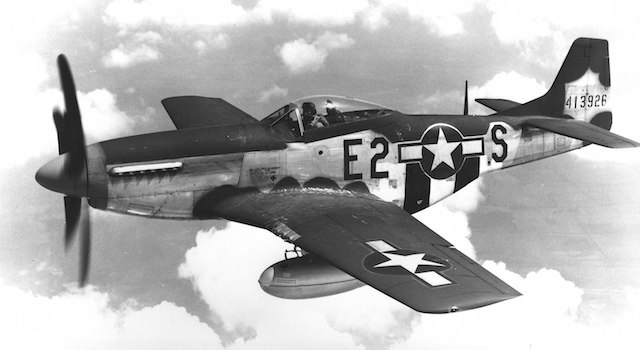 The following Imperial measuring units data is for the famous, full-scale P-51 Mustang.
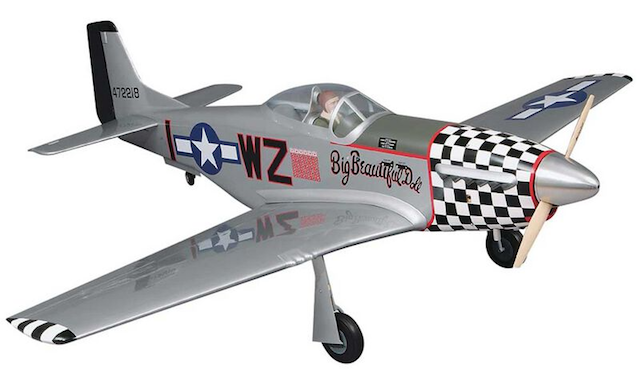
Top Flite 1/5-scale P-51 Model The Top Flite Models 1/5 Giant P-51D Mustang 2.1-2.8 GP ARF is used to compare the Imperial units and numbers used for the full-size P-51 to the Imperial units and numbers used for a model.
The model units presented require the modeler to know that quotation marks can represent inches and that the decimal point is used to represent parts of a foot, not inches. The Imperial unit for model wing loading is usually used with the unit values of ounces per square foot. The weight for the Top Flight P-51 data, needs to be changed to ounces by multiplying the weight, in pounds, 19 - 24 lb., by 16, the number of ounces in a pound, to get the weight in ounces. Also, since the unit in a model's wing area is usually in square feet, the 1245 sq. in. of the Top Flite model's wing area needs to be divided by 144, the number of square inches in a square foot. For those trying to do the math in your head: 19 - 24 lb. is 304 oz. - 384 oz. and 1245 sq. in. is about (~) 8.65 sq.ft. (That wavy line symbol between the parenthesis (~), the tilde, which in mathematics can mean about or very close but not exactly.). 304 oz. divided by (/) 8.65 sq.ft. = ~35.1 oz./sq. ft. (The symbol between parenthesis (/), the fraction or ratio slash, means "divide" by in mathematics.). The greatest wing loading is 384 oz. divided by (/) 8.65 sq. ft. = ~44.4 oz./sq. ft. which is NOT what "they" show as the highest! Top Flite notes the highest wing loading as 35 oz./sq. ft. My personal experience has shown that it is NOT unusual for manufacturer's and supplier's numbers to be "off" a bit. Okay, so I lost some of you folks in the USA here because you can't follow the math, and pretty much the rest of the world, by using Imperial units of measure! It must be a lot easier for the folks in the rest of the world using SI units of measure. "Let's look at it from the "brain" of someone using SI units of measure. Surely, it must be easier. Full scale P-51 Mustang; Gross weight: 4173 kg, Max takeoff weight: 5488 kg, Wingspan: 11 m, Length: 9.83 m, Wing area: 21.8 m2, Wing loading: 190 kg/m2, Stall speed: 160 km/h
Both the full-scale P-51 and the model, in this case, are in the same SI units for mass (weight), kilograms. Note that the units for the wing area notation are different between the full-size and the model P-51. The full-size P-51 uses square meters (m2) and the model P-51 uses square decimeters (dm2) for their respective wing areas. Therefore, the modeler needs to "think" in dm2, just as a modeler using Imperial units needs to "think" in square feet (ft2) compared to square inches (in2). The SI unit of model wing loading is usually used with the unit values of grams per square decimeter, g/dm2. This results in the weight needing to be changed to grams by multiplying the weight, in kilograms, by 1000, the number of grams in a kilogram, to get the weight in grams. For those trying to do the math in your head: 8.61 - 10.88 kg is 8610 g - 10880 g, 8610 g/80.3 dm2 = ~107 g/dm2 and 10880 g/80.3 dm2 = ~135.5 g/dm2. As expected, the calculated values are not what Top Flite noted. Okay, so now I've lost many of the folks in the USA because of the SI units being used, but, hopefully, pretty much of the rest of the world understands the SI units as presented above, except for the use of the period (.) instead of a comma (,) in the SI units. Whether to use a period or comma depends on where you live. "Decimal Points and Markers: In English-speaking countries (except South Africa), in Mexico and in most Asian countries the period (.) is used as the decimal marker (decimal point) to separate the whole number and fractional portions of a number. In continental Europe and most South American countries the decimal marker is the comma (,). The International System (SI) allows either the period or the comma to be used; ..."
Even if the you understand the math for both versions, it is very difficult to envision, in your "mind's eye", the numbers so that they represent the real, three-dimensional object if you were not "born and raised" using those units, or at least having been converted from one to the other for a long time. All of the various types of scientists in the world use the SI system, no matter where they live.For their daily lives, the rest of the world's population uses whatever system they were born into for most of their measurements. As a group, ALL types of modelers have to suffer through conversions of all types, including changing from one unit in the same system to another as well as converting between the SI and Imperial systems. I hear from many of you that my articles containing math seem to indicate that I have a very strong mathematical background. That is NOT true! Teaching 5th grade for over 30 years does not require the mathematical ability or thinking of a rocket scientist! My goal is to simplify the math so that the vast majority of people reading my writings can understand what I am trying to demonstrate. While working on the draft of this article, I brain faded, and used the abbreviation sq.ft2 in my original draft as the abbreviation for square feet. It is not! When read correctly, that abbreviation, sq.ft2 "says" square feet squared! Duh! Square feet is either sq. ft., which is typed as sq. space ft. and read as square feet or ft2, feet raised to the second power or squared, which is also read as square feet. That was a huge head slap. Thank goodness I caught it. It is not easy to keep everything straight! "Google can be used when doing conversions in the same system of units or between the two different units of measurement. By typing in the units that you want to convert from and to into the Google search area, Google presents a work area for you to enter the unit you want to convert and then calculates the unit you want to convert to into the desired unit. Example: Convert wing area in square inches (Imperial) to square decimeters (SI) Type the search term square inches to square decimeters into the Google search box. Press the enter/return key. The following will appear at the top of the Google searched page. 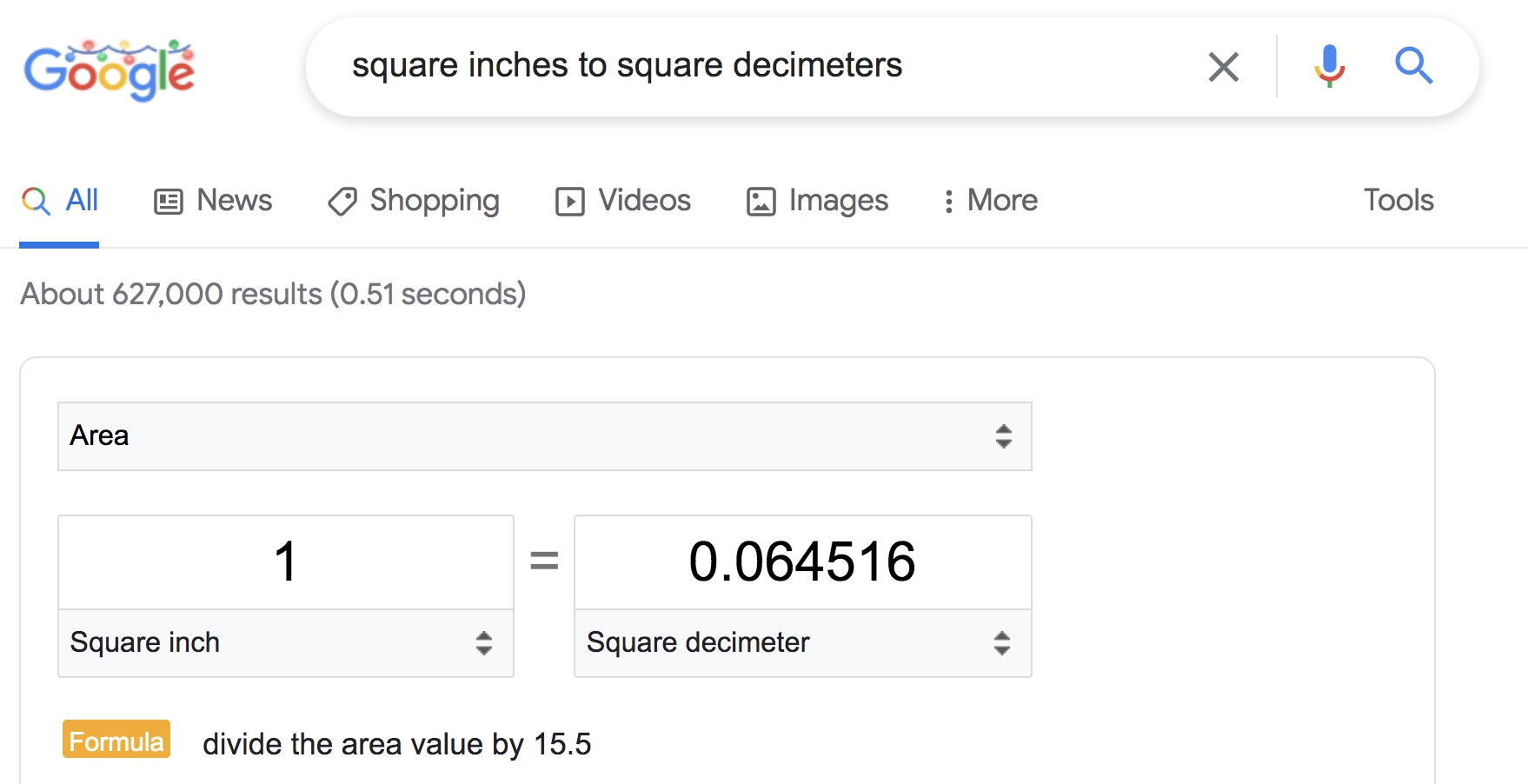 500 was typed into the Square inch input box, for a 500 sq. in. wing, and the result is shown in the Square decimeter output box. 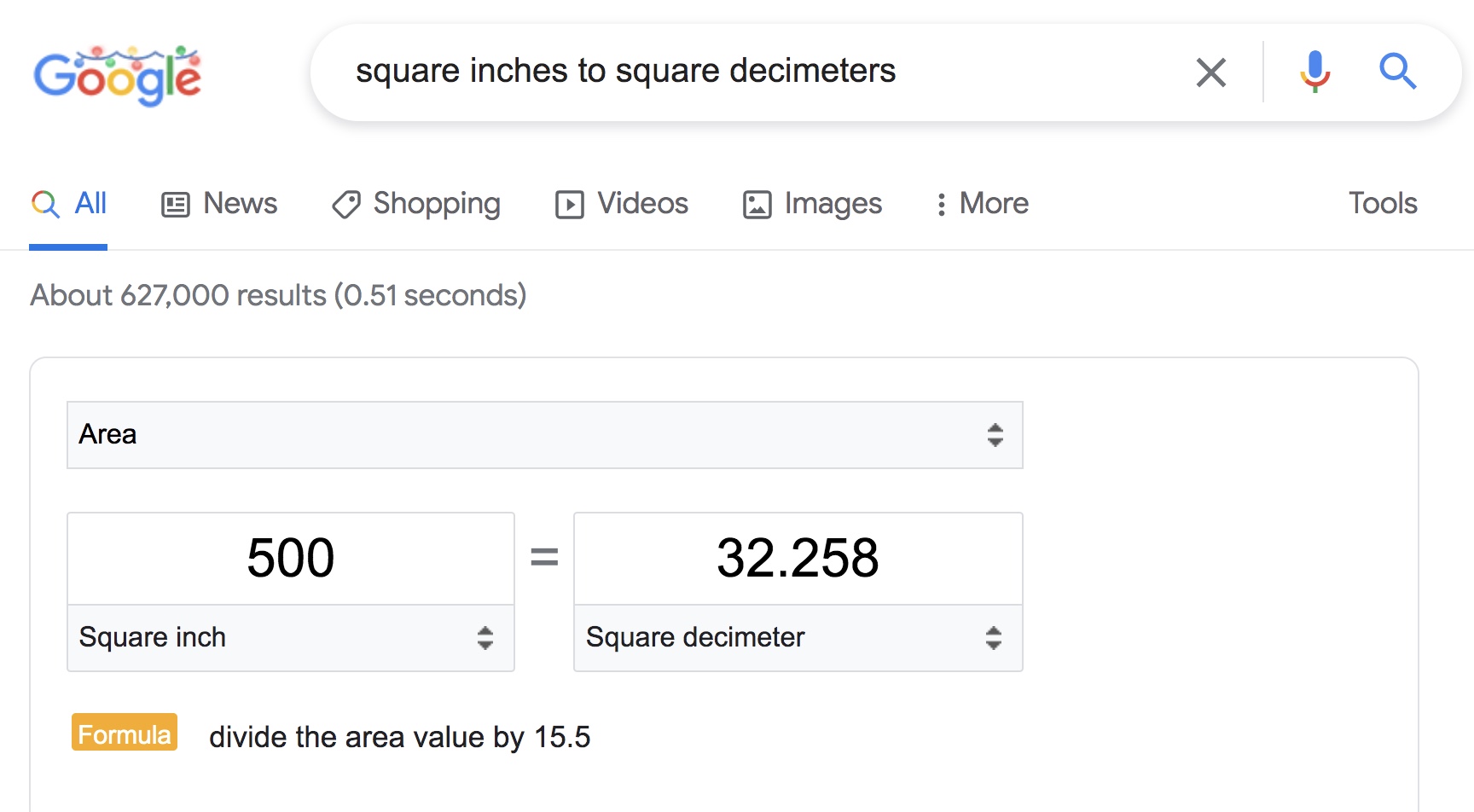 The output box shows that a 500 sq. in. (in2) wing, using the Imperial system, is equal in area to a 32.258 decimeter squared (dm2) wing. The user can also reverse the search term to go from dm2 to in2, square decimeters to square inches. That is a slow process when the user is trying to do many conversions at once, but it does work. I have prepared an Excel workbook that allows the user to convert the numbers that need to be quickly converted for a given airplane within his/her chosen system. The spreadsheet also presents that data for the alternate measurement system so that the user can "see" the thinking that someone using the alternate system might be doing. Furthermore, the spreadsheet provides the data that the user might be looking for regarding a specific fixed wing aircraft. The Excel workbook is named Conversions.xls. Click on the Conversions.xls link to download the Excel spreadsheet workbook.
There are three spreadsheets in the workbook. They are labeled Imperial, SI and Both. Example 1: Using the Imperial spreadsheet for the Full-Size P-51; Gross weight: 9,200 lb., Wingspan: 37 ft., Wing area: 235 sq. ft., Wing loading: 39 lb./sq. ft., Stall speed: 100 mph The required input data of weight in ounces, wingspan in inches and wing area in square feet, is input into cells B11, B12, and B13. Conversion, from the given data for a specific fixed wing aircraft, may be necessary to obtain the units required in this section of the spreadsheet. 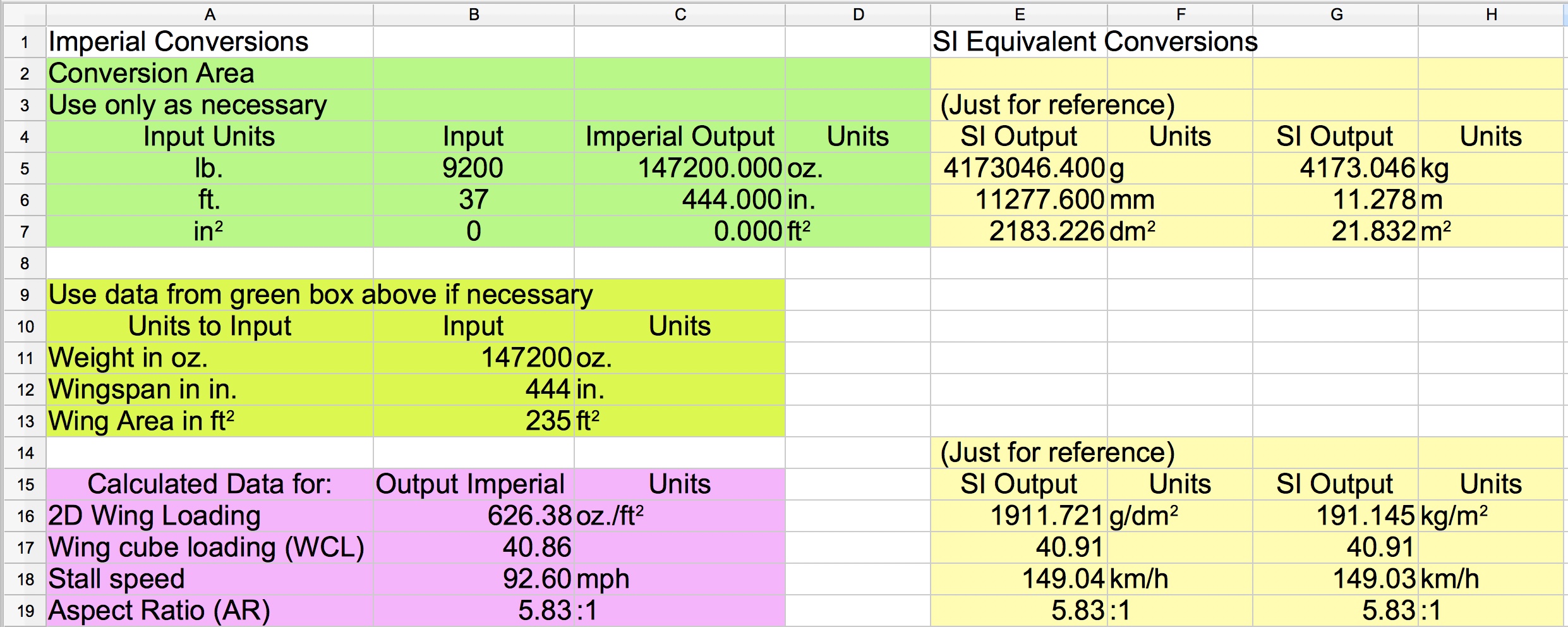 Rows 5, 6, and 7, in the green area, are used for any conversions necessary to obtain the required data inputs. For the full-sized P-51, pounds had to be converted to ounces (B5) and feet to inches (B6). The given wing area was already noted in square feet, therefore it did not need conversion and a zero, place holder, was placed in cell B7. Once the required data, in the required units, is input into cells B11, B12 and B13 the 2D wing loading, in ounces per square foot, the WCL (wing cube loading with no units), the stall speed in mph and the aspect ratio (AR) are calculated and presented. To allow the Imperial "thinker" to visualize what a SI "thinker" needs to "understand" the measurements, the SI equivalents are also noted. The stall speed is calculated using Keith Shaw's formula; stall speed = the square root of the wing area multiplied by 3.7. The calculated stall speed is 92.6 mph and the P-51's stall speed was noted at 100 mph. That is a difference of less than 8% and seems quite reasonable to me. Example 2: Using the SI spreadsheet for the full-size P-51 Full scale P-51 Mustang SI units; Gross weight: 4173 kg, Max takeoff weight: 5488 kg, Wingspan: 11 m, Length: 9.83 m, Wing area: 21.8 m2, Wing loading: 190 kg/m2, Stall speed: 160 km/h Because of the rounding of the SI units of measure in the full-size P-51's data, the manipulation of the decimals places used by the spreadsheet and the chosen conversion factors that I used on the spreadsheet, there is an insignificant difference in the output data when the P-51's given SI units are used as input for the SI spreadsheet. Keep that in mind when using the spreadsheets. 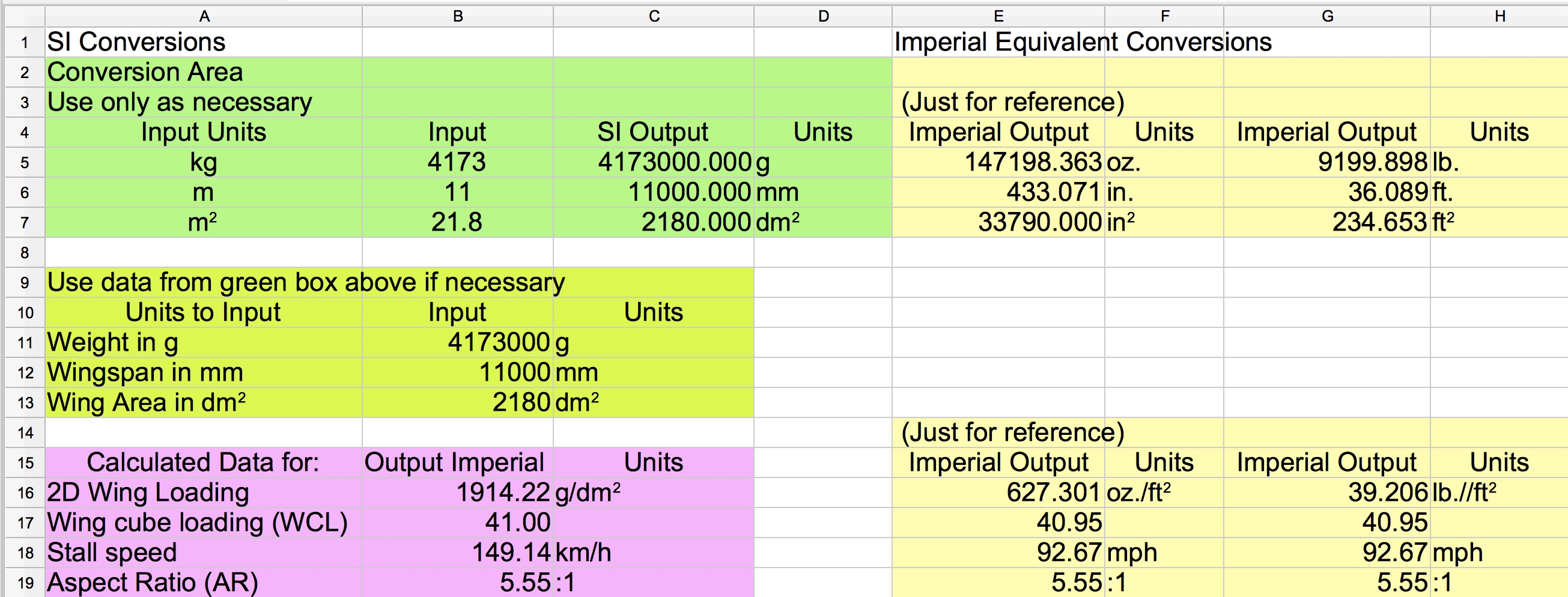 It was necessary to convert all of the data given in SI units for the full-size P-51 to grams, millimeters and square decimeters to obtain the input data required for cells B11, B12 and B13 of the SI spreadsheet. The Imperial outputs for cells G5, G6, G7, G16, and G18 all return extremely similar data to that used as input for the Imperial spreadsheet. On this spreadsheet, the person "thinking" in SI units has a reference to the data that someone "thinking" in the Imperial units of measures uses. The screen captures of the spreadsheets, that follow, show the 1/5-scale Top Flite P-51 in both the Imperial system and the SI system on their respective spreadsheets. The model data has been repeated for ease of comparison Top Flite 1/5-scale P-51 using Imperial Units Weight: 19 - 24 lb., Wingspan: 84.5", Wing Area: 1245 sq. in., Wing Loading: 32 - 35 oz./sq. ft. 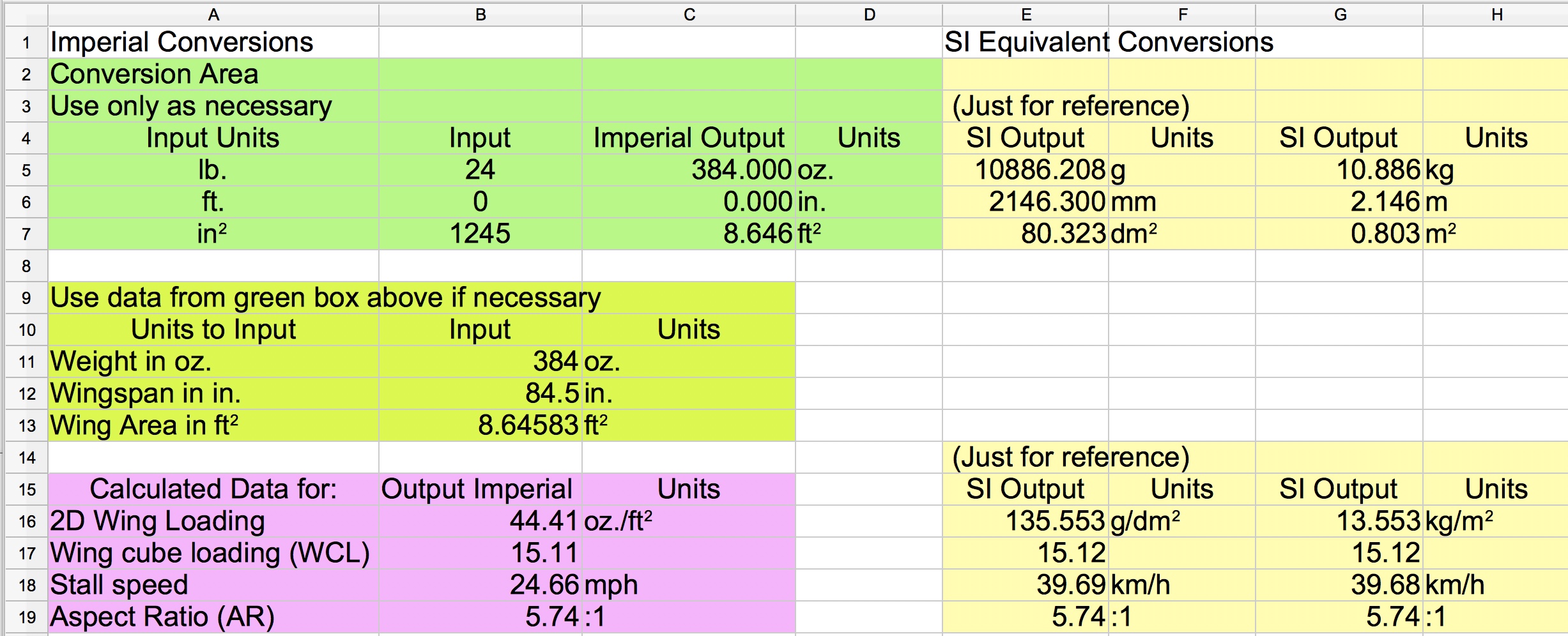 Top Flite 1/5-scale P-51 using SI Units Weight: 8.61 - 10.88 kg, Wingspan: 2146 mm, Wing Area: 80.3 sq dm, Wing Loading: 98 - 107 g/sq dm 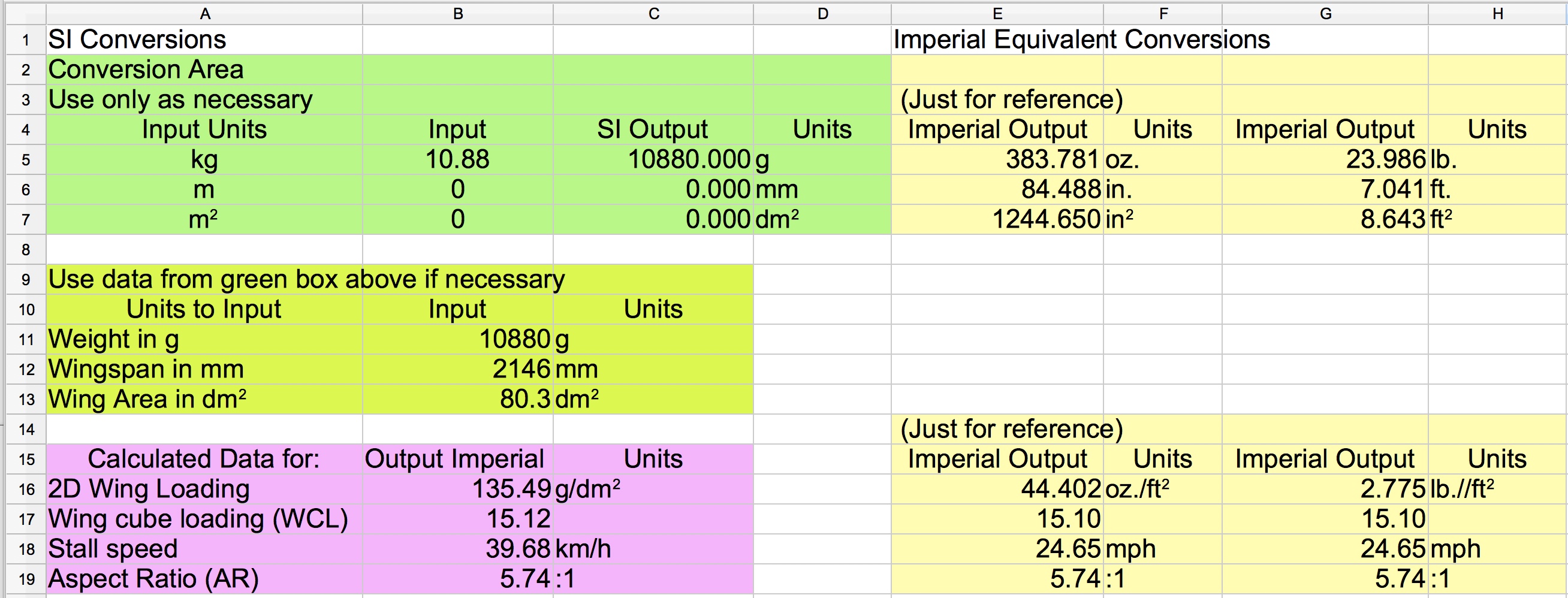 If you download the Excel Workbook, you might enjoy trying some of these models using the spreadsheets. Some of the manufacturers and suppliers use only Imperial units, while others use only the SI units and those that want to sell to the world market use both units. 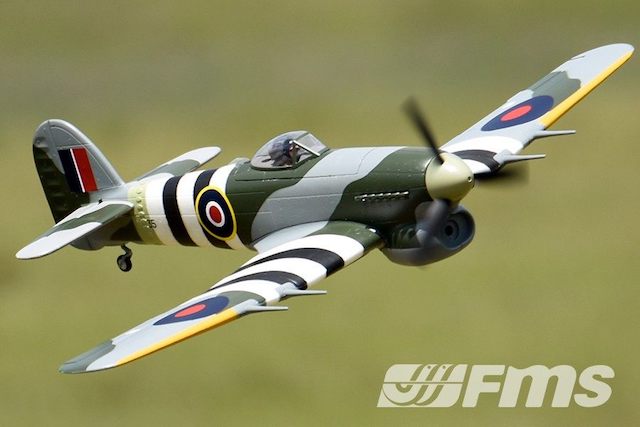
FMS 1100MM (43.3") TYPHOON PNP This is the actual FMS site Wingspan: 1100mm/43.3 in Overall Length: 845mm/33.3 in Flying Weight: Around 1300g (no ounces given) Prop Size: 10.5*7, 3 blade (interesting that this is in inches) Experience Level: Intermediate Wing Load: 66.0 g/dm2 (0.15oz/in2) Wing Area: 19.7dm2 (305.4sq.in) 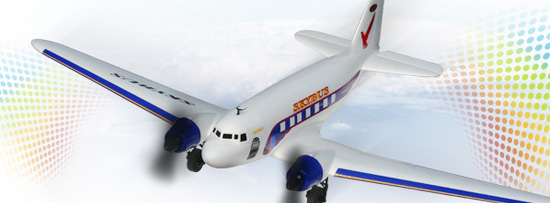
Dynam Skybus (DC-3/C-47 type) Wingspan: 1470mm Fuselage Length: 980mm Flying Weight: 1200g Prop Size: NA Experience Level: Not given Wing Load: 48.8g/dm2 Wing Area: 24.6dm2 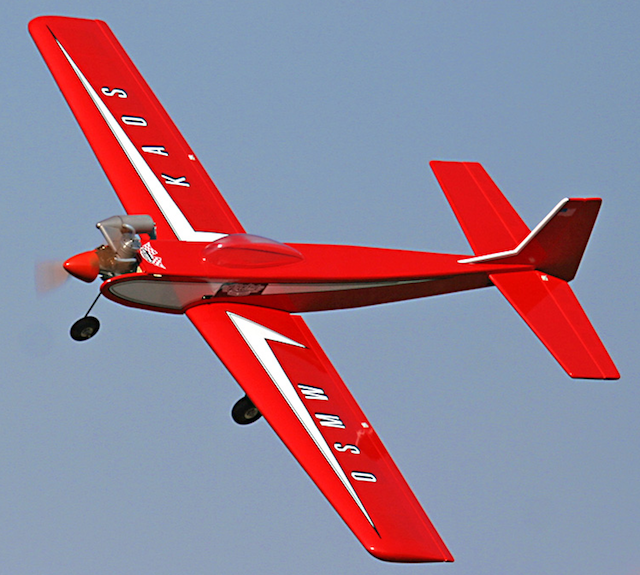
Old School Model Works Kaos Wingspan: 59 inches Fuselage Length: (airframe only): 53 inches Weight: 6.5-8 pounds RTF Prop Size: NA Experience Level: Not given Wing Load: Not given Wing Area: 644 sq. inches 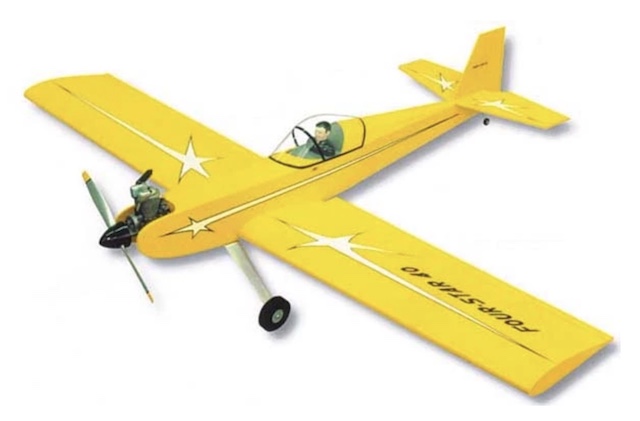
Sig FOUR-STAR 40 KIT Wingspan: 59.75 in/1518 mm Length: 47 in/1194 mm Flying Weight: 4.75 lb/2150 g Prop Size: NA Experience Level: Not given Wing Load: 18 oz/sq ft/55 g/dm2 Wing Area: 604 sq in/39 dm2 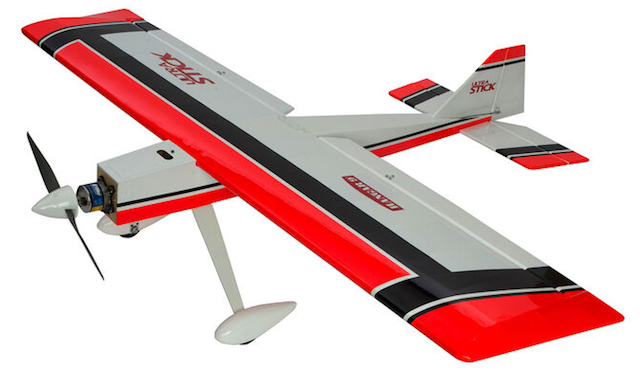
Hangar 9 Ultra Stick 10cc ARF, 60" Wingspan: 60" (1524mm) Product Length: 57" (1448mm) Flying Weight: (not given) (derived from wing loading 111.9375 oz. or ~7 lb.) Prop Size: NA Skill Level: Level 3 Wing Load: 19.9oz/sq ft (SI units not given) Wing Area: 810 sq inches (SI units not given) 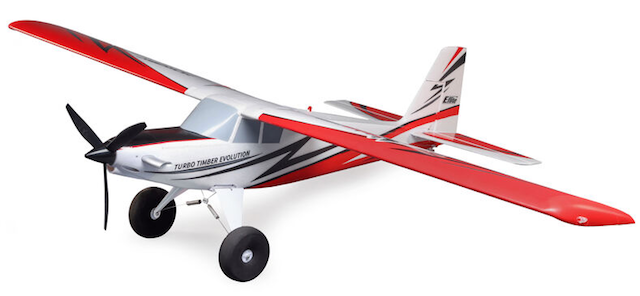
E-flite Turbo Timber Evolution 1.5m BNF Basic, includes Floats Wingspan: 61" (1549 mm) Product Length: 40.9" (1039 mm) Product Weight: 54 - 60oz (1.53 - 1.7kg) Prop Size: NA Skill Level: Level 2 Wing Load: (not given) Wing Area: 559.5 sq in (36.1 sq dm) 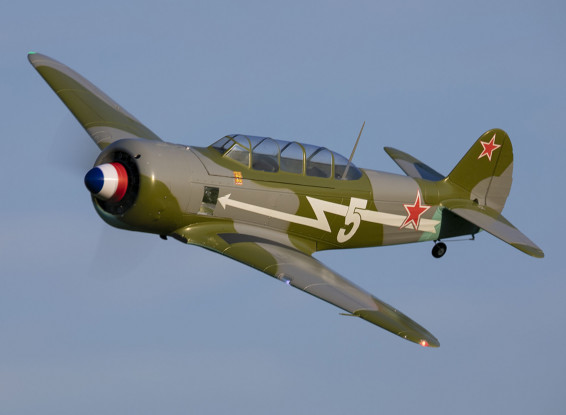
H-King (PNF) Yak-11 Commemorative Russian WW2 Warbird EPO 1450mm (57") Wingspan: 1450mm (57") Length: 1300mm (51") Flying Weight: 2900~3100g (103~110oz) Prop Size: 17x10 (interesting that this is in inches) Skill Level: (not given) Wing Load: (not given) Wing Area: (not given) Hopefully you input the data for these models into the spreadsheets and find out how helpful they might be to you. The seven models clearly illustrate that the amount of data provided by manufacturers and suppliers vary greatly, as well as the usefulness of the information. Happy converting, Ken. Comment Regarding the "My LiPo Died" in the December 2021 Ampeer
I received the following email from Burkhard Erdlenbruch. He noted that my calculation of the average amps for my version of the Simple Cub plane were not correct. He was absolutely correct, so I'll let him explain why. KM Hi Ken, Thanks again for an interesting Ampeer newsletter! You guess that I'm most intrigued by your article, but you baffled me. ;-) I needed some time to understand what it was and now I just want to let you know: it's the amperages you calculated. I had thoroughly read your articles about your Simple Cub versions and couldn't believe they draw that much amps. You mention that the batteries are discharged to 3.8V what is a common storage level. (I do that as well, by the way.) As far as I know that means roughly 40% state of charge, meaning only 60% or 0.78 mAh capacity was drained. Now 46.8 amp minutes would result in 3.3 A or 4.7 A, that is only 2.6C or 3.6C, respectively. Looks more reasonable to me. As a side note, I can report that I had another incident with my Sr. Telemaster battery (You may remember my article in the Dec. 2018 Ampeer.) The replacement battery was taken out of storage this summer as were all other LiPo batteries. All of them still had 3.78V cell voltage after having been charged to 3.85V and stored in the same concrete box for several months. Just one cell of this battery had only 2.4V so it had to be scrapped after only very few flights. The cell had been weak (that is bad) from the beginning (it lagged during charge) - must have slipped quality inspection. As you say: they just die. And another side note: I'm glad to see that Keith Shaw still uses an old Multiplex Cockpit MM transmitter. Makes me a warm feeling. I used the same type of TX in all the years when I developed Reflex simulator models but stepped up to the next size number (RoyalPro) when I changed to 2.4GHz. Still I kept the old transmitter and used it again four years ago to (nostalgically) fly my old ECO Piccolo mini helicopter again. I used the original (18 years old) 6s 600mAh NiCd battery which needed a formation charge and three cycles to come to life again, even if only 70% of its nominal capacity. But the later NiMH batteries had died long ago - only NiCd is so resilient. Enough ranting. Best wishes and stay healthy! Burkhard Skymasters Indoor Flying starting October 20 through April 13, 2022
HELLO INDOOR FLIERS! We're back for Indoor Flying starting October 20th! I'm very happy to announce that through the efforts of Fred Engleman and Paul Goelz we have an agreement with Reimagine Recreation to fly on Wednesdays at United Wholesale Mortgage Sports Complex (formerly Ultimate Soccer). It was a bit of a struggle dealing with the new owners of the facility and I would really like to thank Fred and Paul for stepping up and pushing us to the finish line! There are some differences beyond the fact that we will be flying on field 4 (the one in the back) since field 3, where we used to fly, is now a basketball and volleyball arena. Everyone who enters the building for any reason during our time slot MUST SIGN A LIABILITY WAIVER. It would be helpful if you print a copy, sign and bring to your first flying session but we will have printed waivers on hand too. Park out back by field 4. You will not be allowed to enter the front door. To simplify this year, we went with only Gold (season pass) cards for $150 and single sessions at $10 each. Also, since ReImagine charges Skymasters for each and every pilot who flies, youths and spouses are no longer free. Here is a direct link to register and purchase a Gold Card or print out a registration form for your first single session. Hope to see many of you on the 20th, or before, at the Night Fly and Free Tailgate Swap at Skymasters' Field. Indoor Flying - Wednesday, October 20, 2021 - UWM Sports Complex, 837 South Blvd, Pontiac, MI
Contact: Fred Engleman
Updated Information 11/01/21: FYI - For those of you who want to park a little closer, we found out that the early morning Wednesday, UWM Training Sessions let out at 10 and the parking lot empties out quickly making more room for us closer to entrance of Field #4.
11/10/21: It seemed to work well that pilots who arrived few minutes after 10 were able to park closer to entrance for Field #4.
Indoor Flying at the Legacy Center in Brighton, MI Indoor flying takes place from November 3rd, 2021 until March 30th, 2022 at the Legacy Center Sports Complex, 9299 Goble Dr., Brighton, MI 48116, phone: 810.231.9288, on Wednesdays from 12:30 PM until 2:30 PM.
To Reach Ken Myers, you can land mail to the address at the top of the page. My E-mail address is: KMyersEFO@theampeer.org |
